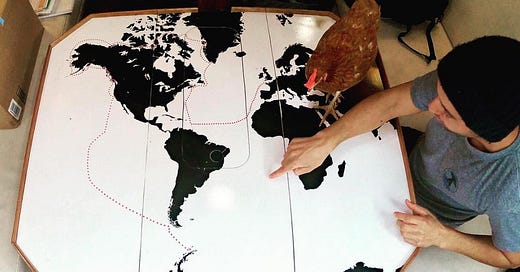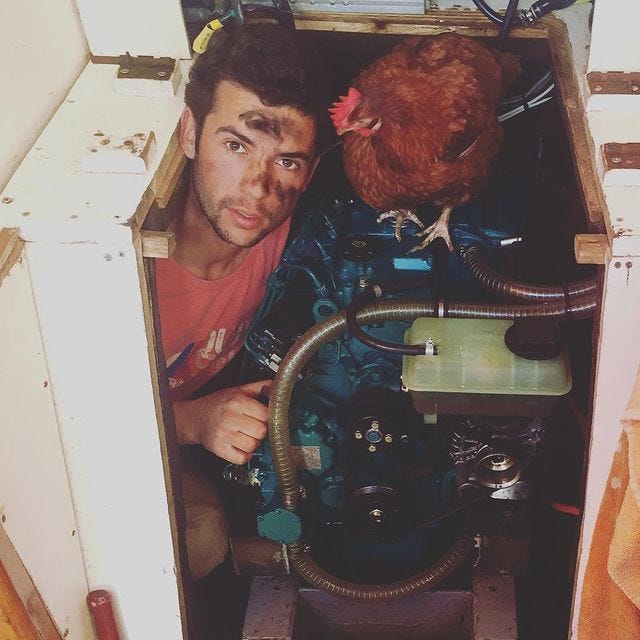In 2014, a young French sailor, committed to crossing the Atlantic solo on his sailboat, stopped in the Canary Islands to get a pet. He considered a cat, historically a popular animal on voyages thanks to their rodent-killing abilities, but decided against it. What Guirec Soudée wanted was a chicken. They were easy. They laid eggs. What could go wrong?
People told him it would never work. The hen would be too stressed by the movement of the ocean. She’d certainly never lay an egg. And where do you keep a coop on board? But Soudée ignored them. A chicken was the perfect pet to share an Atlantic crossing with.
Monique, as he named the little red hen, laid an egg on her first day on board. Because chickens are social creatures, they became a flock of two. Soudée built coops for her on and below deck so she’d always have a safe place no matter how bad the weather got. They travelled the world together for the next five years, sharing moments from their voyage together to social media. Soudée refers to her, affectionately, as Momo. Now at least six years old, Momo has had a longer life than most little red hens. Whether that’s due to the sea air or the companionship is hard to say.
It might seem unusual to take a chicken, a bird that famously returns to the coop each night to roost, on such an epic adventure but chickens have always been world travelers. It’s why there are chickens on nearly every island and continent inhabited by humans today. Easter Island, famous for its statues, is also dotted with stone chicken coops built by the same people who made the enigmatic Moai. It was so common for Polynesian seafarers to bring chickens with them during their ocean migration that geneticists are using chicken DNA from old bones to make a map of sorts showing when various tropical islands were first habited.
During the “hen fever” of the 1800s which saw the prices of exotic breeds of chickens skyrocket, there was a wild trade of rare birds who travelled by ship between Asian countries, England, and the United States. There were even expensive chickens brought onto the Titanic by a first-class passenger named Ella White. While White survived, her poultry wasn’t so lucky.
Chickens have become part the culture of the sea. Along with anchors and swallows, one common sailor’s tattoo is the pairing of a chicken and a pig. There are a lot of explanations for the symbolism behind this tattoo—my favorite is that since pigs and chickens were sometimes the only survivors of a shipwreck, maybe they’d bring luck to a sailor too.
Of course most of these birds were either cargo or livestock, not pets like Monique, and today chickens are much more likely to take a road trip than cross the ocean. As pet chickens become members of the family as beloved as cats and dogs, stories of chickens in cars are becoming more common—albeit still somewhat newsworthy. Earlier this year a family that took their special needs chicken (and duck and dogs) on a 7100 mile road trip made the news. Sammi the chicken (another little red hen like Monique) now has over 47 thousand followers on Instagram thanks to her weekend road trips with her owner Dave.
Wherever human go, we bring our chickens with us. Together, we’ve had spectacular adventures.
News from the Coop
After over a month with no sign of the hawk I wrote about in my last newsletter, I finally let the chickens out for a few short, unsupervised hours. Of course, disaster struck. As best as I can piece it together, it tried to attack Emmylou first (we found a pile of her feathers during the hour it took us to find her in her very good hiding spot) and when that didn’t work went for our dust mop of a frizzle, Harriet. It was sad and stressful for everyone. I know the hawk was only doing what it was made to do but I wish it would do it somewhere else—or at least go for one of the robins or other wild birds in the yard instead of my pets. Emmylou hardly left the nest for four days after the attack. She’s more or less back to normal but chicken trauma is very real.
I think that this ongoing threat means Scully and Emmylou are going to be the last bantams we have at this house. It’s just too dangerous. Though a hawk can attack a full size chicken Cooper’s hawks are pretty small and it’s a lot less likely. Now the only time the flock gets to free range is when I’m with them and I’m scared to let them out of my sight. It’s a perennial question with chicken keepers: do I let them free-range knowing they are so much happier or do I keep them in a coop where I know they’ll be safe? Until recently the risk of danger seemed so low that it was worth it. Clearly we can’t trust this hawk to move on and that’s not the case anymore.
In better news, you might remember Mr. Marple (née Miss Marple), our oopsie-roo who had to find a new home back in June. I was lucky enough to find him a home with a very nice woman who doesn’t live too far away and over the weekend I got to visit him for the first time since I gave him up! He’s pretty camera shy (and hardly crows) but is giant and gorgeous and seems very happy with his flock of twelve ladies. Not every rooster finds such a good home and it was great to get to see him again—even if he didn’t remember me.
If you need a chicken fix before the next newsletter, you can follow me on Twitter or Instagram.
If you liked this email, please share the newsletter with a chicken or animal lover in your life! As always, email me at underthehenfluence@gmail.com with any tips or comments. See you in a few weeks.
-Tove








Can't wait for your book!